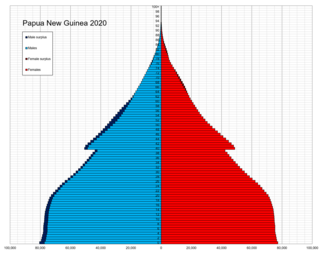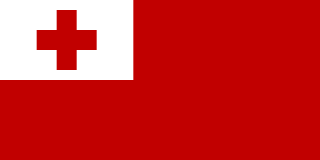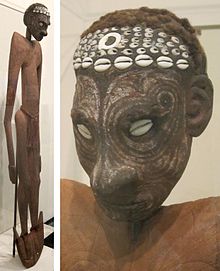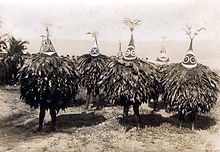
The indigenous population of Papua New Guinea is one of the most heterogeneous in the world. Papua New Guinea has several thousand separate communities, most with only a few hundred people. Divided by language, customs, and tradition, some of these communities have engaged in endemic warfare with their neighbors for centuries. It is the second most populous nation in Oceania, with a total population estimated variously as being between 9.5 and 10.1 million inhabitants.

Melanesia is a subregion of Oceania in the southwestern Pacific Ocean. It extends from New Guinea in the west to the Fiji Islands in the east, and includes the Arafura Sea.
Sanguma was a Papua New Guinean musical ensemble active from 1977 to 1985. They combined music from the cultural tradition of Papua New Guinea with Western instruments and were one of the first Papua New Guinean music groups to perform internationally. Sanguma formed at the National Arts School in 1977 and performed in their homeland at the South Pacific Festival of Arts in 1980. Sanguma were nurtured very closely in their early days by the Australian musician Ric Halstead, who was a lecturer at the National Arts School in Port Moresby from whence Sanguma originated and Les McLaren.
Goroka is the capital of the Eastern Highlands Province of Papua New Guinea. It is a town of approximately 19,000 people (2000), 1,600 meters above sea level. It has an airport and is on the "Highlands Highway", about 285 km from Lae in Morobe province and 90 km from the nearby town of Kainantu also in the Eastern Highlands. Other nearby towns include Kundiawa in Simbu Province and Mount Hagen in Western Highlands Province. It has a mild climate, known as a "perpetual Spring".

The Evangelical Lutheran Church of Papua New Guinea is a Protestant church denomination located in Papua New Guinea that professes the Lutheran branch of the Christian faith. The Church is incorporated by a 1991 Act of the Parliament of Papua New Guinea and it has a baptized membership of approximately 900,000 members.
The Baháʼí Faith formed in the late 19th century in the Middle East, later gaining converts in India, East Africa, and the Western world. Traveling promoters of the religion played a significant role in spreading the religion into most countries and territories during the second half of the 20th century, mostly seeded out of North America by the planned migration of individuals. The Baháʼí Faith was recognized as having a widespread international membership by the 1980s, and is now recognized as the second-most geographically widespread religion after Christianity.
Unity of humanity is one of the central teachings of the Baháʼí Faith. The Baháʼí teachings state that since all humans have been created in the image of God, God does not make any distinction between people regardless of race or colour. Thus, because all humans have been created equal, they all require equal opportunities and treatment. Thus the Baháʼí view promotes the unity of humanity, and that people's vision should be world-embracing and that people should love the whole world rather than just their nation. The teaching, however, does not equate unity with uniformity, but instead the Baháʼí writings advocate for the principle of unity in diversity where the variety in the human race is valued.

The Society of the Divine Word, abbreviated SVD and popularly called the Verbites or the Divine Word Missionaries, and sometimes the Steyler Missionaries, is a Catholic clerical religious congregation of Pontifical Right for men. As of 2020, it consisted of 5,965 members composed of priests and religious brothers working in more than 70 countries, now part of VIVAT international. It is one of the largest missionary congregations in the Catholic Church. Its members add the nominal letters SVD after their names to indicate membership in the Congregation. The superior general is Paulus Budi Kleden who hails from Indonesia.
The Catholic Church in Papua New Guinea is part of the worldwide Catholic Church, under the spiritual leadership of the Pope in Rome. Papua New Guinea has approximately two million Catholic adherents, approximately 27% of the country's total population.
The Rhenish Missionary Society was one of the largest Protestant missionary societies in Germany. Formed from smaller missions founded as far back as 1799, the Society was amalgamated on 23 September 1828, and its first missionaries were ordained and sent off to South Africa by the end of the year.

Christianity is the most widely professed religion in Zimbabwe, with Protestantism being its largest denomination.

Christianity is the largest religion in Vanuatu. Vanuatu is an archipelago made up of 13 larger islands, and approximately 70 smaller surrounding islands, each home to multitudes of diverse cultural and religious communities.

Christianity is the predominant religion in Kiribati, with Catholicism being its largest denomination.

Christianity is the predominant religion in Tonga, with Methodists having the most adherents.
This is a list of selected references for Christianity in China.
The Baháʼí Faith in New Caledonia was first mentioned by ʻAbdu'l-Bahá in 1916, though the first Baháʼí arrived in 1952 during a temporary visit because of restrictive policies on English-speaking visitors. In 1961 Jeannette Outhey was the first New Caledonian to join the religion. On the same year, Emma and Georges Wayenece were the first melanesian couple to accept the Faith of Baha'u'llah. With other converts and pioneers, they elected the first Baháʼí Local Spiritual Assembly of Nouméa in 1962. The Baháʼí National Spiritual Assembly of New Caledonia was elected in 1977. Multiplying its involvements through to today, the 2001 population was reported at 1,070. The Association of Religion Data Archives estimated some 955 Baháʼís in 2005.
The Baháʼí Faith in Papua New Guinea begins after 1916 with a mention by ʻAbdu'l-Bahá, then head of the religion, that Baháʼís should take the religion there. The first Baháʼís move there in Papua New Guinea arrived there in 1954. With local converts the first Baháʼí Local Spiritual Assembly was elected in 1958. The first National Spiritual Assembly was then elected in 1969. According to the census of 2000 showed that the number of Baháʼís does not exceed 21000. But the Association of Religion Data Archives estimated three times more Baháʼís at 200.000 or 6% of the nation were Baháʼís in 2015 Either way it is the largest minority religion in Papua New Guinea, if a small one.
The Baháʼí Faith is a minority religion in all the countries of Oceania. Baháʼí Houses of Worship are present in Australia, Samoa, and Vanuatu, and another is under construction in Papua New Guinea. Malietoa Tanumafili II of Samoa was a follower of the Baháʼí Faith and the first Baháʼí head of state.

The Church of Jesus Christ of Latter-day Saints in Papua New Guinea refers to the Church of Jesus Christ of Latter-day Saints and its members in Papua New Guinea (PNG). The first missionaries arrived in 1980. As of December 31, 2022, there were 36,626 members in 92 congregations, making it the largest body of LDS Church members in Melanesia and the fifth largest in Oceania.












